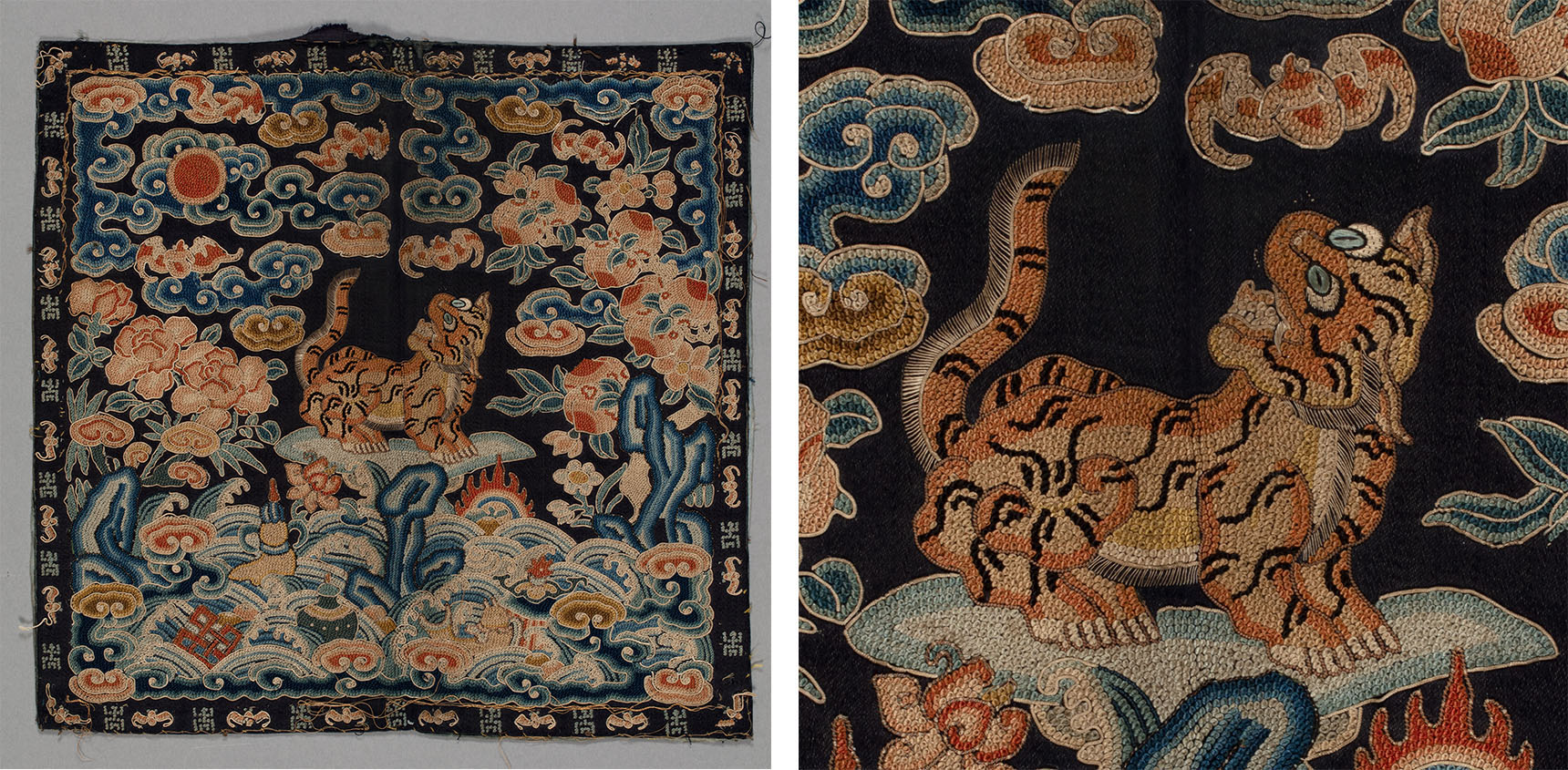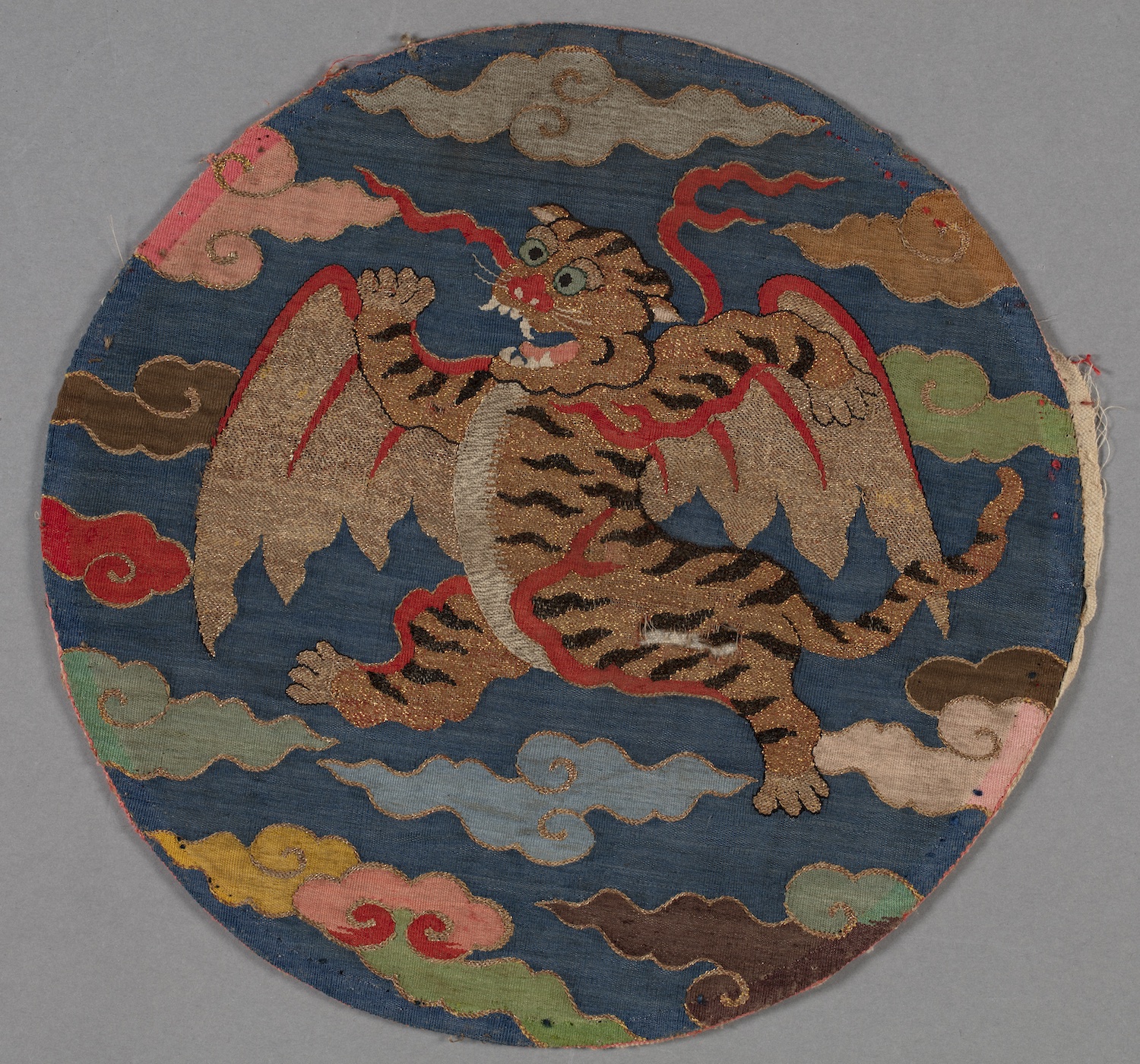2022 Year of the Tiger: Rank Badges from the Mactaggart Art Collection
The Year of the Tiger starts in February as a new lunar calendar begins. As the king of the forest, the tiger is an important symbol in the zodiac as it represents vitality and courage and demonstrates a bold and strong character. Therefore, during the Ming (1368-1644) and Qing (1644-1911) dynasties the tiger was used as a fierce symbol on fourth rank military official’s rank badges. The Chinese imperial court also decorated the imperial army banners with tigers, called tiger flags, emphasizing the militaristic symbolism of this ferocious beast.
The Mactaggart Art Collection has a vast collection of rank badges. Below are three rank badges from the collection all featuring the tiger to celebrate the lunar new year.
Chinese imperial courts distinguished ranks by using roundel insignia for the aristocratic robes and square badges for officials' robes. This tiger roundel badge (Figure 1) is silk tapestry and would have been attached to the back of a robe.
Artisans depicted the tiger with wings and in an active pose to create a powerful and striking image. Metal-wrapped threads were used to weave the body of the tiger and to adorn it with red flames. Colourful clouds decorate the background in the cardinal colours, as the tiger seemingly floats in the foreground. The design on this roundel shows an early Qing style.
Rank badges were designed to be worn on both the front and back of a centre-open robe or surcoat. Both rank badges are identical in design, with the front badge slit down the middle to accommodate the garment opening. The official and his spouse were both allowed to wear badges aligned with the man’s rank, and when they wore their official costumes side-by-side, the sun images were in the middle between them. The position of the animal and sun on the rank badge dictates the gender of the wearer: male badges had the sun on the left, while women’s badges had the sun on the right. The Family Portrait (2007.23.1) painting is a good example that shows men in surcoats with rank badges.
The design (Figure 2), rendered in delicate tapestry with painted details, shows a tiger standing on a small hill, his head looking back towards the sun - the red circle on the right side. From this, we can tell that this rank badge would have been worn by the wife of a fourth rank military official. Blue clouds float on the upper field, and waves and rocks are below the tiger. Two bats, which are a symbol of good fortune, hang upside down at the top, surrounded by other auspicious emblems.
Chinese artisans grouped auspicious emblems, including the Daoist eight emblems, Buddhist eight treasures, or other combinations of treasures, to decorate textiles and bless the wearer. On the upper row, from left to right, there is a fan and flute, a basket and castanets (a type of percussion instrument), a gourd and a fish drum, a sword and a lotus bud. These are the Daoist eight emblems. In the middle of the background, there are two coins and a roll on the left to the tiger, and a ruyi and chime on the right. Interestingly, the artisans also put eight Buddhist emblems in the waves, from left to right, including a vase, a fish, the wheel, a lotus, the parasol, the victory banner, the endless knot, and the conch. Could you find each of them?
The rank badge in Figure 3 (below) belonged to a fourth-rank military official. He could have been a police vice-director in the capital county or a lieutenant colonel of a royal troop and would have worn this back panel rank badge during the Qing dynasty.
A tiger stands on a flat stone in the centre of the panel with its head turning backwards towards the sun - a red circle on the left. Curled clouds gather on the top and are scattered around the tiger. Decorative peaches and peonies, representing longevity and fortune, surround the tiger. The bottom is filled with waves and rocks and decorated with the Buddhist eight treasures (includes a lotus, the victory banner, a vase and the endless knot on the left of the rock, and the wheel, the conch, the parasol and the fish on the right) and coloured clouds. The panel’s border is framed with a narrow band and embroidered with bats (to represent fortune) and symbols of longevity.
The fine craftsmanship of this embroidery is both exquisite and delicate. Numerous expertly-crafted tiny knots of different colours evenly and smoothly fill the pattern area, as shown in Figure 4. In addition, they used couching stitches (a method used to attach a thread or group of threads to fabric) to outline the pattern. Satin stitches fill the tiger’s eyes and decorate its tail.

Figure 3 & 4. "Back Panel of the Rank Badge for a Fourth Rank Military Official" and Detail, Qing 19th century; Embroidery; Mactaggart Art Collection , University of Alberta Museums; Gift of Sandy and Cécile Mactaggart; 2005.5.596.2

Figure 1. "Back Panel Silk Tapestry Weave Military Roundel", Qing 17th-18th centuries; Mactaggart Art Collection , University of Alberta Museums; Gift of Sandy and Cécile Mactaggart; 2005.5.239.2

Figure 2. "Front and back Panels of a Rank Badge for a Fourth Rank Military Official," Qing 19th centuries; Mactaggart Art Collection, University of Alberta Museums; Gift of Sandy and Cécile Mactaggart; 2005.5.595.1-2